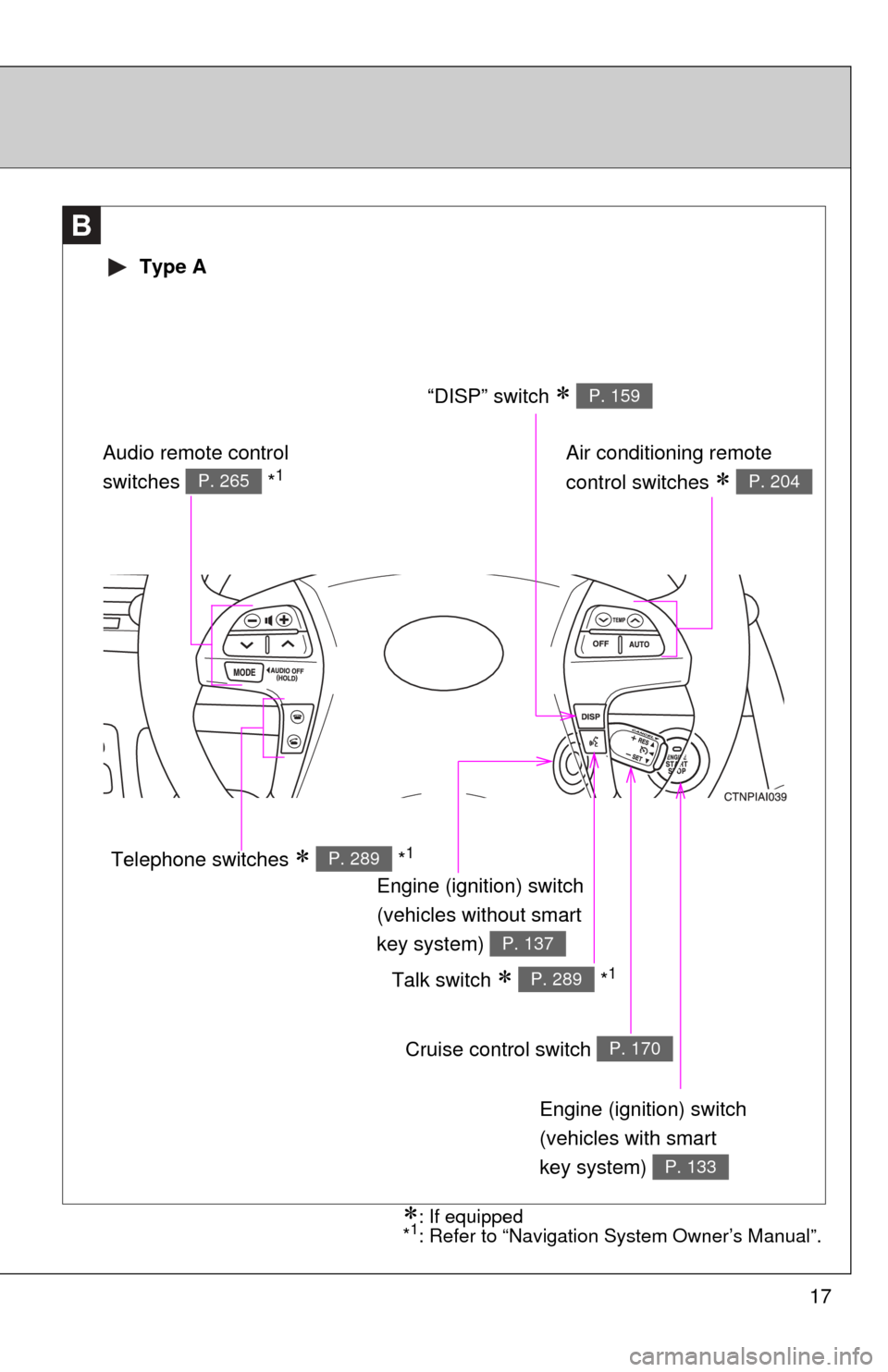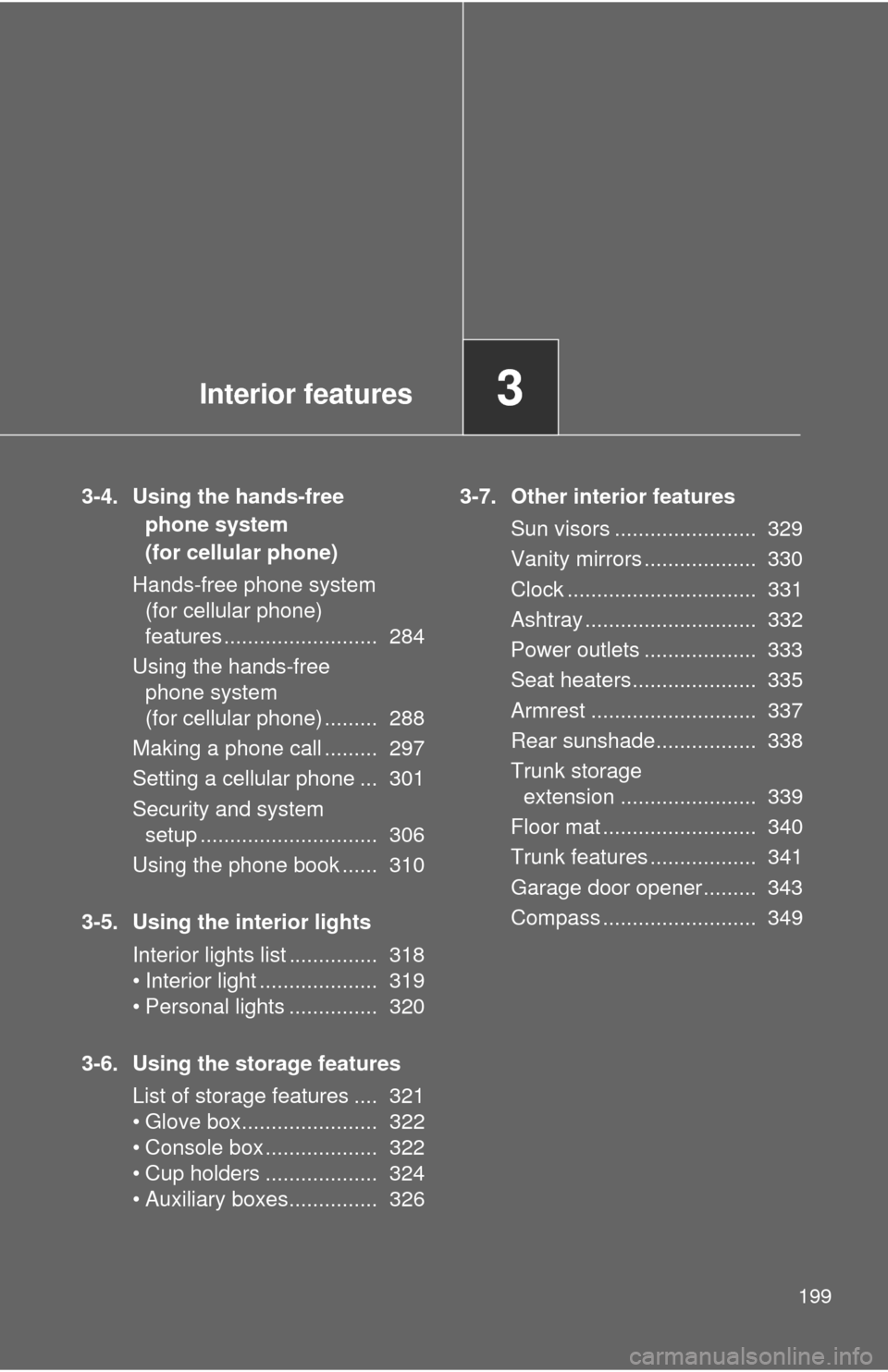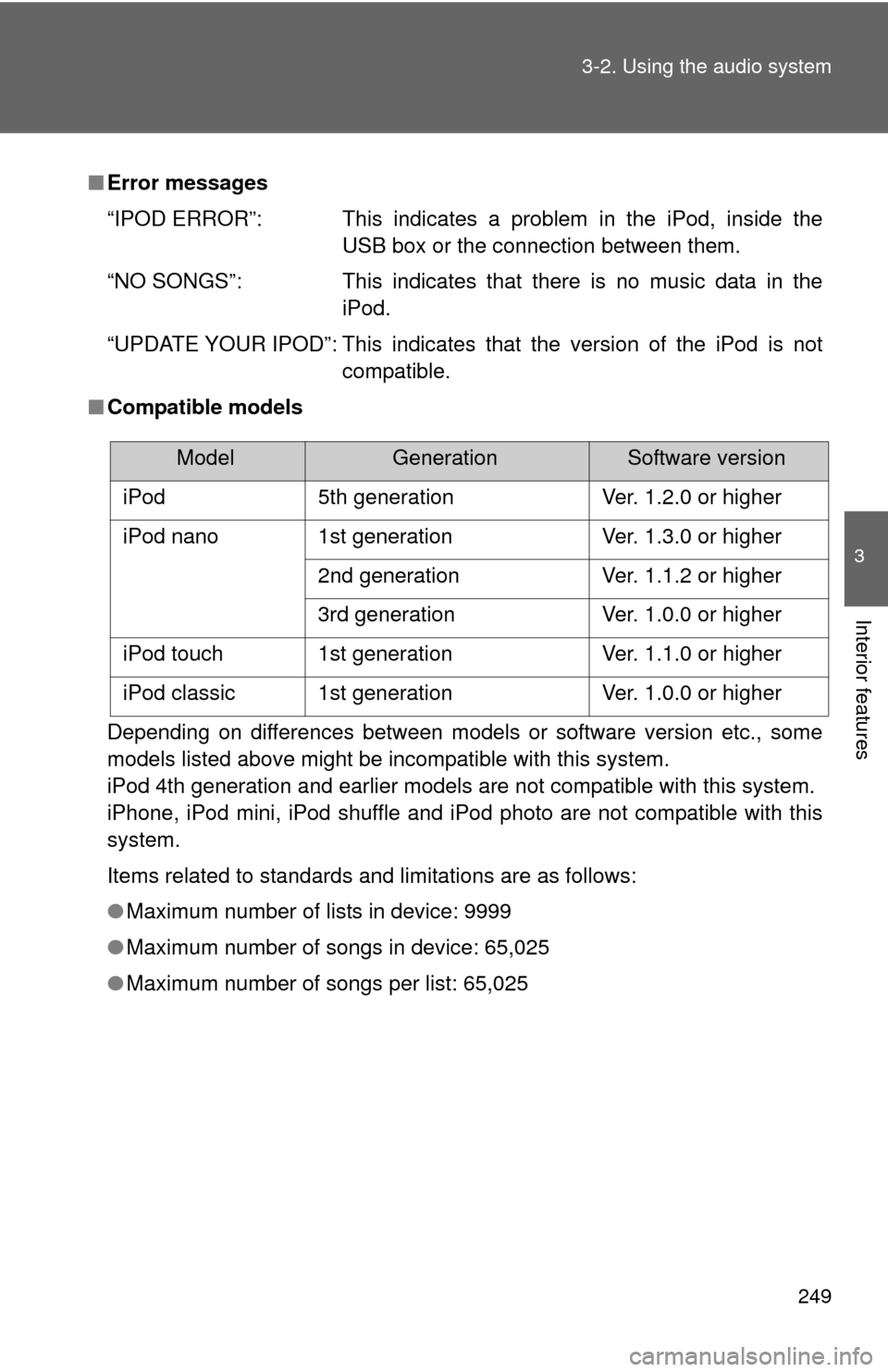phone TOYOTA CAMRY 2011 XV50 / 9.G Owners Manual
[x] Cancel search | Manufacturer: TOYOTA, Model Year: 2011, Model line: CAMRY, Model: TOYOTA CAMRY 2011 XV50 / 9.GPages: 554, PDF Size: 9.69 MB
Page 4 of 554

TABLE OF CONTENTSIndex
4
3-3. Using the Bluetooth® audio
system
Bluetooth
® audio system .... 268
Using the Bluetooth®
audio system .................... 271
Operating a Bluetooth
®
enabled portable player ... 276
Setting up a Bluetooth
®
enabled portable player ... 278
Bluetooth
® audio system
setup ................................ 283
3-4. Using the hands-free phone system
(for cellular phone)
Hands-free phone system (for cellular phone)
features ............................ 284
Using the hands-free phone system
(for cellular phone) ........... 288
Making a phone call ........... 297
Setting a cellular phone...... 301
Security and system setup ................................ 306
Using the phone book ........ 310
3-5. Using the interior lights Interior lights list ................. 318
• Interior light ...................... 319
• Personal lights ................. 320
3-6. Using the storage features List of storage features....... 321
• Glove box ......................... 322
• Console box ..................... 322
• Cup holders ...................... 324
• Auxiliary boxes ................. 326 3-7. Other interior features
Sun visors ........................... 329
Vanity mirrors ..................... 330
Clock................................... 331
Ashtray ............................... 332
Power outlets ...................... 333
Seat heaters ....................... 335
Armrest ............................... 337
Rear sunshade ................... 338
Trunk storage extension ..... 339
Floor mat ............................ 340
Trunk features .................... 341
Garage door opener ........... 343
Compass ............................ 349
4-1. Maintenance and care Cleaning and protecting the vehicle exterior ........... 354
Cleaning and protecting the vehicle interior ............ 356
4-2. Maintenance Maintenance requirements .................... 359
General maintenance ......... 361
Emission inspection and maintenance (I/M)
programs .......................... 364
4Maintenance and care
Page 17 of 554

17
B
Engine (ignition) switch
(vehicles with smart
key system)
P. 133
Cruise control switch P. 170
Talk switch *1P. 289
Air conditioning remote
control switches
P. 204
Engine (ignition) switch
(vehicles without smart
key system)
P. 137
“DISP” switch P. 159
Telephone switches *1P. 289
Audio remote control
switches *1P. 265
Type A
: If equipped
*1: Refer to “Navigation System Owner’s Manual”.
Page 18 of 554

18
B
Type B
Cruise control switch P. 170
Talk switch *1P. 289
Engine (ignition) switch
(vehicles without smart
key system)
P. 137
Telephone switches
*1P. 289
Audio remote control
switches *1P. 265
Pictorial indexInstrument panel
Engine (ignition) switch
(vehicles with smart key system)
P. 133
Page 22 of 554

22
CAUTION
■General precautions while driving
Driving under the influence: Never drive your vehicle when under the influ-
ence of alcohol or drugs that have impaired your ability to operate your vehi-
cle. Alcohol and certain drugs delay reaction time, impair judgment and
reduce coordination, which could lead to an accident that could result in
death or serious injury.
Defensive driving: Always drive defensively. Anticipate mistakes that other
drivers or pedestrians might make and be ready to avoid accidents.
Driver distraction: Always give your full attention to driving. Anything that dis-
tracts the driver, such as adjusting controls, talking on a cellular phone or
reading can result in a collision with resulting death or serious injury to you,
your occupants or others.
■ General precaution regarding children’s safety
Never leave children unattended in the vehicle, and never allow children to
have or use the key.
Children may be able to start the vehicle or shift the vehicle into neutral.
There is also a danger that children may injure themselves by playing with
the cigarette lighter, the windows, or other features of the vehicle. In addi-
tion, heat build-up or extremely cold temperatures inside the vehicle can be
fatal to children.
Page 33 of 554

33
1-2. Opening, closing and locking the doors and trunk
1
Before driving
●
Near a TV tower, electric power plant, gas station, radio station, large dis-
play, airport or other facility that generates strong radio waves or electri-
cal noise
● When carrying a portable radio, ce llular phone, cordless phone or other
wireless communication devices
● When the electronic key has come into contact with, or is covered by, a
metallic object
● When multiple electronic keys are in the vicinity
● When carrying or using the electronic key together with the following
devices that emit radio waves
• Another vehicle’s electronic key
• A wireless key that emits radio waves
• Personal computer
● If window tint with a metallic content or metallic objects are attached to
the rear window
■ Switching the door unlock function
It is possible to set which doors the entry function unlocks.
Turn the “ENGINE START STOP” switch OFF.
When the indicator on the key surface is off, press and
hold , , or for approximately 5 seconds while
pressing on the key.
The setting changes each time an operation is performed, as shown below.
(When changing the setting continuously, release the buttons, wait for at
least 5 seconds, and repeat step 2.)
STEP1
STEP2
Multi-information displayUnlocking doorsBeep
Hold the driver's door han-
dle to unlock only the
driver's door. Exterior: Beeps three
times
Interior: Pings once
Hold the front passenger's
door handle to unlock all
doors
Hold either front door han-
dle to unlock all doors Exterior: Beeps twice
Interior: Pings once
Page 34 of 554

34 1-2. Opening, closing and locking the doors and trunk
Unlock the doors using the electronic key and open one of the
doors.
If a door is not opened within 60 seconds after is pressed, the
doors will be locked again and the alarm will automatically be set.
In case that the alarm is triggered, immediately stop the alarm.
(P. 85)
■ Battery-saving function
In the following circumstances, the entry function is disabled in order to pre-
vent the vehicle and electronic key batteries from discharging.
●When the entry function has not been used for 2 weeks or more
● When the electronic key has been left within approximately 6 ft. (2 m) of
the vehicle for 10 minutes or more
The system will resume operation when...
● The vehicle is locked using the door handle lock switch.
● The vehicle is locked/unlocked using the wireless remote control func-
tion. ( P. 4 0 )
● The vehicle is locked/unlocked using the mechanical key. ( P. 473)
■ Electronic key battery depletion
●The standard battery life is 1 to 2 years. (The battery becomes depleted
even if the electronic key is not used.) If the smart key system or the
wireless remote control function does not operate, or the detection area
becomes smaller, the battery may be depleted. Replace the battery when
necessary. ( P. 406)
● If the battery becomes low, an alarm will sound in the cabin when the
engine stops. ( P. 36, 454)
● To avoid serious deterioration, do not leave the electronic key within 3 ft.
(1 m) of the following electrical appliances that produce a magnetic field.
•TVs
• Personal computers
• Recharging cellular phones or cordless phones
• Table lampsSTEP3
Page 42 of 554

42 1-2. Opening, closing and locking the doors and trunk
■Key battery depletion
Vehicles with smart key system
P. 3 4
Vehicles without smart key system
The standard battery life is 1 to 2 years. (The battery becomes depleted
even if the key is not used.) If the wireless remote control function does not
operate, the battery may be depleted. Replace the battery when necessary.
( P. 406)
■ Security feature
If a door is not opened within approximately 60 seconds after the vehicle is
unlocked, the security feature automatically locks the vehicle again.
■ When the electronic key battery is fully depleted (vehicles with smart
key system)
P. 406
■ Conditions affecting operation
Vehicles with smart key system
P. 3 2
Vehicles without smart key system
The wireless remote control function may not operate normally in the follow-
ing situations.
● Near a TV tower, radio station, electr ic power plant, airport or other facil-
ity that generates strong radio waves
● When carrying a portable radio, cell ular phone or other wireless commu-
nication devices
● When multiple wireless keys are in the vicinity
● When the wireless key has come into contact with, or is covered by, a
metallic object
● When a wireless key (that emits radio waves) is being used nearby
● When the wireless key has been left near an electrical appliance such as
a personal computer
■ Customization that can be co nfigured at Toyota dealer
Settings (e.g. trunk unlocking function) can be changed.
(Customizable features P. 516)
Page 199 of 554

Interior features3
199
3-4. Using the hands-free phone system
(for cellular phone)
Hands-free phone system (for cellular phone)
features .......................... 284
Using the hands-free phone system
(for cellular phone) ......... 288
Making a phone call ......... 297
Setting a cellular phone ... 301
Security and system setup .............................. 306
Using the phone book ...... 310
3-5. Using the interior lights Interior lights list ............... 318
• Interior light .................... 319
• Personal lights ............... 320
3-6. Using the storage features List of storage features .... 321
• Glove box....................... 322
• Console box ................... 322
• Cup holders ................... 324
• Auxiliary boxes............... 326 3-7. Other interior features
Sun visors ........................ 329
Vanity mirrors ................... 330
Clock ................................ 331
Ashtray ............................. 332
Power outlets ................... 333
Seat heaters..................... 335
Armrest ............................ 337
Rear sunshade................. 338
Trunk storage extension ....................... 339
Floor mat .......................... 340
Trunk features .................. 341
Garage door opener......... 343
Compass .......................... 349
Page 218 of 554

218 3-2. Using the audio system
Language settings (type B and C)The language used for all voice guidance, voice recognition and mes-
sages may be changed.
Press .
Press that corresponds to “MORE”.
Press that corresponds to “LANG”.
Press that corresponds to the desired language.
For vehicles sold in the U.S.A.
“ENG” (English) or “ESP” (Spanish)
For vehicles sold in Canada
“ENG” (English) or “FRAN” (French)
■ Using cellular phones
Interference may be heard through the audio system's speakers if a cellular
phone is being used inside or close to the vehicle while the audio syste\
m is
operating.
STEP1
STEP2
STEP3
STEP4
Page 249 of 554

249
3-2. Using the audio system
3
Interior features
■
Error messages
“IPOD ERROR”: This indicates a problem in the iPod, inside the
USB box or the connection between them.
“NO SONGS”: This indicates that there is no music data in the iPod.
“UPDATE YOUR IPOD”: This indicates that the version of the iPod is not compatible.
■ Compatible models
Depending on differences between models or software version etc., some
models listed above might be incompatible with this system.
iPod 4th generation and earlier models are not compatible with this system.
iPhone, iPod mini, iPod shuffle and iPod photo are not compatible with this
system.
Items related to standards and limitations are as follows:
●Maximum number of lists in device: 9999
● Maximum number of songs in device: 65,025
● Maximum number of songs per list: 65,025
ModelGenerationSoftware version
iPod 5th generation Ver. 1.2.0 or higher
iPod nano 1st generation Ver. 1.3.0 or higher 2nd generation Ver. 1.1.2 or higher
3rd generation Ver. 1.0.0 or higher
iPod touch 1st generation Ver. 1.1.0 or higher
iPod classic 1st generation Ver. 1.0.0 or higher